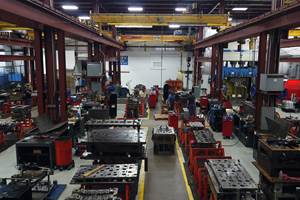Tracking Tools in the Cloud
Whether for a local mold shop or a globally renowned supplier, a centralized system for reviewing and analyzing data is key.
System integration is essential for reviewing data and analytics, centralizing communication channels, maintaining collaborative operations and tracking all affiliated information. The more complex a company’s operations are, the more valuable the analytics. Whether it’s a local mold shop or a globally renowned supplier, the need for a centralized system is proving more beneficial to all of the parties involved. Instead of managing information in multiple systems, users should opt for an all-inclusive system to manage information internally and throughout the supply chain, enabling improved collaboration. A decentralized system can negatively influence the success of the work, cost money, increase the likelihood of error or management oversight, and simply complicate the process.
Many manufacturers already rely on data tracking to review order status, cycle-time performance and product quality, but some now are also digitizing their strategies, and producing faster and more accurately while lowering costs and reducing lost time. Location tracking of molds via the cloud is a key component to a centralized system, and using an all-inclusive tool management documentation platform will help provide the necessary tools to do this. This platform should not only store and share files, but also provide real-time updates, issue reporting, custom alert notifications and GPS location tracking from one centralized system. An app option will also allow a shop’s customers to access their information via the cloud and guarantees that the pertinent tooling data remains with the mold no matter where it travels.
QR and bar codes are becoming more commonly used to track tools and assets. Merging such technology with the cloud streamlines communication among multiple positions within a company, makes file sharing more transparent and readily available, and shortens the approval process. Additionally, when a mold shop receives an OEM request for information on a mold that was completed years prior and that is no longer in the shop, that cloud-based system can provide speedy, convenient access to that information.
For example, when a mold shop sends out large files, they typically must go through a data manager, then to another department that handles file transfers and formatting, and finally to a separate team for distribution. The right tool management documentation platform simplifies this process. It cuts the number of people in the process and does not require an individual to wait on someone else in order to access information. It allows the mold shop to communicate directly to all of its customers from one system. This digital process also reduces the amount of paperwork involved and keeps the supply chain aware of the current program’s status, which helps avoid unexpected delays. With the right tool management documentation platform, a moldmaker can upload a mold design to a cloud database, where it can be viewed instantaneously and signed off on by the customer.
The cloud can be readily accessed through smartphones, desktop computers and any other Wi-Fi-accessible technology, and mobile apps are safer and more secure than ever. Simply logging onto a website or using an app can transform an entire operation. It can improve the flow of information and data, increasing efficiency. Also, by tracking tools and managing data, a company can better preserve its inventory, reducing maintenance costs and the risk of lost information across the supply chain.
Tracking tools in the cloud can entice all roles in a company to be involved in the production process. Mold builders no longer need to make large investments in enterprise resource planning or onsite systems and hardware. The cloud enables shops to improve collaboration, boost workflow and increase automation.
Related Content
How to Select a Mold Temperature Controller
White paper shares how cooling channel analysis, which collects maximum pressure drop, total flow rate and heat dissipation, eases the performance evaluation of mold temperature controllers.
Read MoreLeading Mold Manufacturers Share Best Practices for Improving Efficiency
Precise Tooling Solutions, X-Cell Tool and Mold, M&M Tool and Mold, Ameritech Die & Mold, and Cavalier Tool & Manufacturing, sit down for a fast-paced Q&A focused on strategies for improving efficiencies across their operations.
Read MoreTolerancing in Mold Design, Part 2: Using GD&T to Address Conventional Tolerancing Issues
Mold designers can achieve a single interpretation of workpiece functionality when following the American Society of Mechanical Engineers Geometric Dimensioning and Tolerancing standard.
Read MoreIndiana Mold Builder Decatur Mold Offers a History of Grit and a Future of Innovation
Decatur Mold Tool and Engineering Inc. serves as a tooling tour guide, helping busy tooling managers reduce uncertainty, lighten workload.
Read MoreRead Next
The Data-Driven Operation
Manufacturing is a team effort involving suppliers, tool shops and customers throughout the world collaborating and sharing project data.
Read MoreHow to Use Continuing Education to Remain Competitive in Moldmaking
Continued training helps moldmakers make tooling decisions and properly use the latest cutting tool to efficiently machine high-quality molds.
Read MoreHow to Use Strategic Planning Tools, Data to Manage the Human Side of Business
Q&A with Marion Wells, MMT EAB member and founder of Human Asset Management.
Read More.jpg;maxWidth=970;quality=90)





















